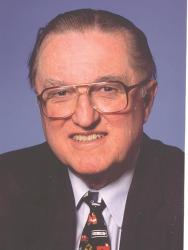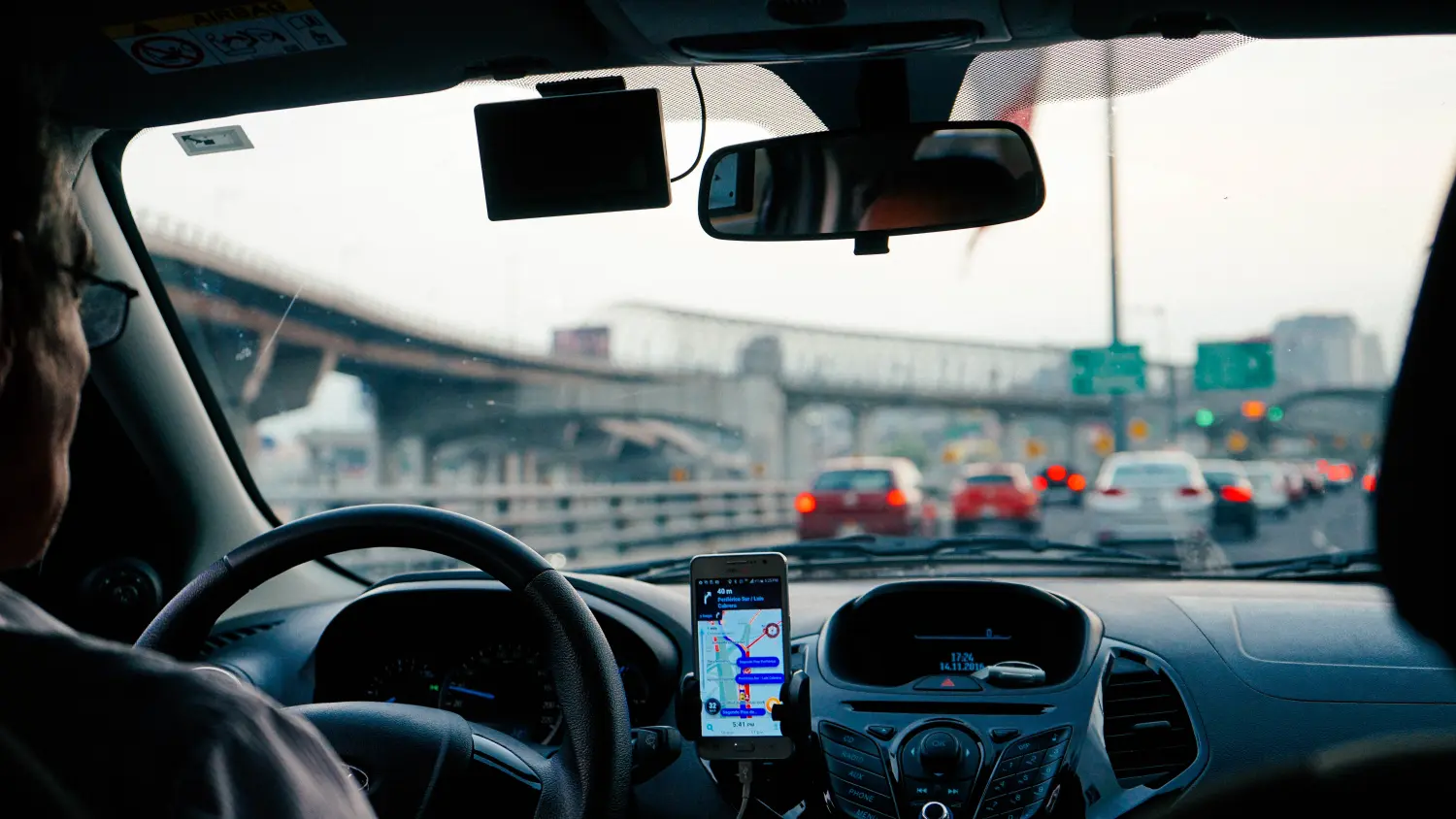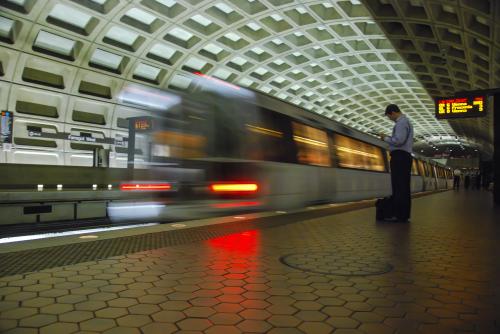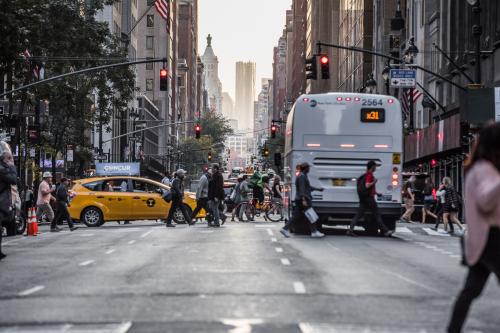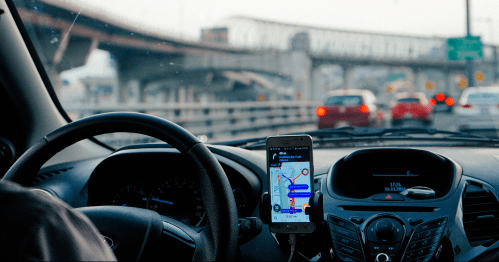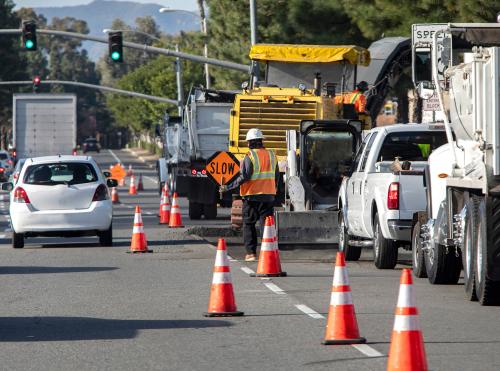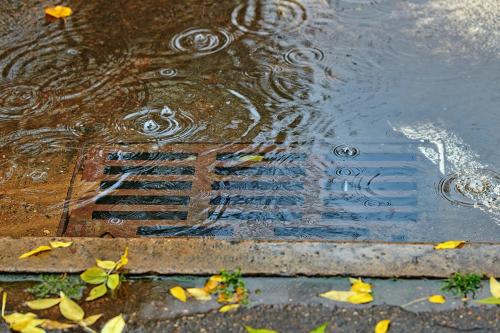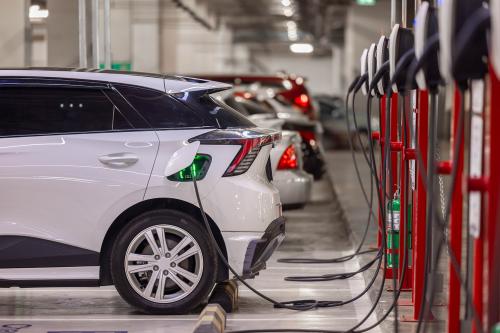Contents
- Introduction
- The Real Problem
- Coping With the Mobility Problem
- The Principle of Triple Convergence
- Triple Convergence and Other Proposals
- How Population Growth Can Swamp Transportation Capacity
- Low-Density Settlements
- Possible Improvements
- Conclusion
Rising traffic congestion is an inescapable condition in large and growing metropolitan areas across the world, from Los Angeles to Tokyo, from Cairo to Sao Paolo. Peak-hour traffic congestion is an inherent result of the way modern societies operate. It stems from the widespread desires of people to pursue certain goals that inevitably overload existing roads and transit systems every day. But everyone hates traffic congestion, and it keeps getting worse, in spite of attempted remedies.
Commuters are often frustrated by policymakers’ inability to do anything about the problem, which poses a significant public policy challenge. Although governments may never be able to eliminate road congestion, there are several ways cities and states can move to curb it.
POLICY BRIEF #128
The Real Problem
Traffic congestion is not primarily a problem, but rather the solution to our basic mobility problem, which is that too many people want to move at the same times each day. Why? Because efficient operation of both the economy and school systems requires that people work, go to school, and even run errands during about the same hours so they can interact with each other. That basic requirement cannot be altered without crippling our economy and society. The same problem exists in every major metropolitan area in the world.
In the United States, the vast majority of people seeking to move during rush hours use private automotive vehicles, for two reasons. One is that most Americans reside in low-density areas that public transit cannot efficiently serve. The second is that privately owned vehicles are more comfortable, faster, more private, more convenient in trip timing, and more flexible for doing multiple tasks on one trip than almost any form of public transit. As household incomes rise around the world, more and more people shift from slower, less expensive modes of movement to privately owned cars and trucks.
With 87.9 percent of America’s daily commuters using private vehicles, and millions wanting to move at the same times of day, America’s basic problem is that its road system does not have the capacity to handle peak-hour loads without forcing many people to wait in line for that limited road space. Waiting in line is the definition of congestion, and the same condition is found in all growing major metropolitan regions. In fact, traffic congestion is worse in most other countries because American roads are so much better.
Coping With the Mobility Problem
There are four ways any region can try to cope with the mobility challenge. But three of them are politically impractical or physically and financially impossible in the United States.
Charging peak-hour tolls. Governments can charge people money to enter all the lanes on major commuting roads during peak hours. If tolls were set high enough and collected electronically with “smart cards,” the number of vehicles on each major road during peak hours could be reduced enough so that vehicles could move at high speeds. That would allow more people to travel per lane per hour than under current, heavily congested conditions.
Transportation economists have long been proponents of this tactic, but most Americans reject this solution politically for two reasons. Tolls would favor wealthier or subsidized drivers and harm poor ones, so most Americans would resent them, partly because they believe they would be at a disadvantage.
The second drawback is that people think these tolls would be just another tax, forcing them to pay for something they have already paid for through gasoline taxes. For both these reasons, few politicians in our democracy—and so far, anywhere else in the world—advocate this tactic. Limited road-pricing schemes that have been adopted in Singapore, Norway, and London only affect congestion in crowded downtowns, which is not the kind of congestion on major arteries that most Americans experience.
Greatly expanding road capacity. The second approach would be to build enough road capacity to handle all drivers who want to travel in peak hours at the same time without delays. But this “cure” is totally impractical and prohibitively expensive. Governments would have to widen all major commuting roads by demolishing millions of buildings, cutting down trees, and turning most of every metropolitan region into a giant concrete slab. Those roads would then be grossly underutilized during non-peak hours. There are many occasions when adding more road capacity is a good idea, but no large region can afford to build enough to completely eliminate peak-hour congestion.
Greatly expanding public transit capacity. The third approach would be to expand public transit capacity enough to shift so many people from cars to transit that there would be no more excess demand for roads during peak hours. But in the United States in 2000, only 4.7 percent of all commuters traveled by public transit. (Outside of New York City, only 3.5 percent use transit and 89.3 percent use private vehicles.) A major reason is that most transit commuting is concentrated in a few large, densely settled regions with extensive fixed-rail transit systems. The nine U.S. metropolitan areas with the most daily transit commuters, when taken together, account for 61 percent of all U.S. transit commuting, though they contain only 17 percent of the total population. Within those regions, transit commuters are 17 percent of all commuters, but elsewhere, transit carries only 2.4 percent of all commuters, and less than one percent in many low-density regions.
Even if America’s existing transit capacity were tripled and fully utilized, morning peak-hour transit travel would rise to 11.0 percent of all morning trips. But that would reduce all morning private vehicle trips by only 8.0 percent—certainly progress, but hardly enough to end congestion—and tripling public transit capacity would be extremely costly. There are many good reasons to expand the nation’s public transit systems to aid mobility, but doing so will not notably reduce either existing or future peak-hour traffic congestion.
Living with congestion. This is the sole viable option. The only feasible way to accommodate excess demand for roads during peak periods is to have people wait in line. That means traffic congestion, which is an absolutely essential mechanism for American regions—and most other metropolitan regions throughout the world—to cope with excess demands for road space during peak hours each day.
Although congestion can seem intolerable, the alternatives would be even worse. Peak-hour congestion is the balancing mechanism that makes it possible for Americans to pursue other goals they value, including working or sending their children to school at the same time as their peers, living in low-density settlements, and having a wide choice of places to live and work.
The Principle of Triple Convergence
The least understood aspect of peak-hour traffic congestion is the principle of triple convergence, which I discussed in the original version of Stuck in Traffic (Brookings/Lincoln Institute of Land Policy, 1992). This phenomenon occurs because traffic flows in any region’s overall transportation networks form almost automatically self-adjusting relationships among different routes, times, and modes. For example, a major commuting expressway might be so heavily congested each morning that traffic crawls for at least thirty minutes. If that expressway’s capacity were doubled overnight, the next day’s traffic would flow rapidly because the same number of drivers would have twice as much road space. But soon word would spread that this particular highway was no longer congested. Drivers who had once used that road before and after the peak hour to avoid congestion would shift back into the peak period. Other drivers who had been using alternative routes would shift onto this more convenient expressway. Even some commuters who had been using the subway or trains would start driving on this road during peak periods. Within a short time, this triple convergence onto the expanded road during peak hours would make the road as congested as it was before its expansion.
Experience shows that if a road is part of a larger transportation network within a region, peak-hour congestion cannot be eliminated for long on a congested road by expanding that road’s capacity.
The triple convergence principle does not mean that expanding a congested road’s capacity has no benefits. After expansion, the road can carry more vehicles per hour than before, no matter how congested it is, so more people can travel on it during those more desirable periods. Also, the periods of maximum congestion may be shorter, and congestion on alternative routes may be lower. Those are all benefits, but that road will still experience some period of maximum congestion daily.
Triple Convergence and Other Proposals
Triple convergence affects the practicality of other suggested remedies to traffic congestion. An example is staggered work hours. In theory, if a certain number of workers are able to commute during less crowded parts of the day, that will free up space on formerly congested roads. But once traffic moves faster on those roads during peak hours, that will attract other drivers from other routes, other times, and other modes where conditions have not changed to shift onto the improved roads. Soon the removal of the staggered-working-hour drivers will be fully offset by convergence.
The same thing will happen if more workers become telecommuters and work at home, or if public transit capacity is expanded on off-road routes that parallel a congested expressway. This is why building light rail systems or even new subways rarely reduces peak-hour traffic congestion. In Portland, where the light rail system doubled in size in the 1990s, and in Dallas, where a new light rail system opened, congestion did not decline for long after these systems were up and running. Only road pricing or higher gasoline taxes are exempt from the principle of triple convergence.
How Population Growth Can Swamp Transportation Capacity
A ground transportation system’s equilibria can also be affected by big changes in the region’s population or economic activity. If a region’s population is growing rapidly, as in Southern California or Florida, any expansions of major expressway capacity may soon be swamped by more vehicles generated by the added population. This result is strengthened because America’s vehicle population has been increasing even faster than its human population. From 1980 to 2000, 1.2 more automotive vehicles were added to the vehicle population of the United States for every 1.0 person added to the human population (though this ratio declined to 1 to 1 in the 1990s). The nation’s human population is expected to grow by around 60 million by 2020—possibly adding another 60 million vehicles to our national stock. That is why prospects for reducing peak-hour traffic congestion in the future are dim indeed.
Shifts in economic activity also affect regional congestion. During the internet and telecommunications boom of the late 1990s, congestion in the San Francisco Bay Area intensified immensely. After the economic “bubble” burst in 2000, congestion fell markedly without any major change in population. Thus, severe congestion can be a sign of strong regional prosperity, just as reduced congestion can signal an economic downturn.
The most obvious reason traffic congestion has increased everywhere is population growth. In a wealthy nation, more people means more vehicles. But total vehicle mileage traveled has grown much faster than population. From 1980 to 2000, the total population of the United States rose 24 percent, but total vehicle miles traveled grew 80 percent because of more intensive use of each vehicle. The number of vehicles per 1,000 persons rose 14 percent and the number of miles driven per vehicle rose 24 percent. Even without any population gain in those two decades, miles driven would have risen 47 percent.
One reason people drove their vehicles farther is that a combination of declining real gas prices (corrected for inflation) and more miles per gallon caused the real cost of each mile driven to fall 54 percent from 1980 to 2000. That helped raise the fraction of U.S. households owning cars from 86 percent in 1983 to 92 percent in 1995.
Furthermore, American road building lagged far behind increases in vehicle travel. Urban lane-miles rose by 37 percent versus an 80 percent increase in miles traveled. As a result, the amount of daily traffic that was congested in the 75 areas analyzed in studies by the Texas Transportation Institute went from 16 percent in 1982 to 34 percent in 2001.
Another factor in road congestion is accidents and incidents, which some experts believe cause half of all traffic congestion. From 1980 to 2000, the absolute number of accidents each year has remained amazingly constant, and the annual number of traffic deaths in the United States fell 18 percent, in spite of the great rise in vehicle miles traveled. So accidents could only have caused more congestion because roads were more crowded, and each accident may now cause longer back-ups than before.
Incidents are non-accident causes of delay, such as stalled cars, road repairs, overturned vehicles, and bad weather. No one knows how many incidents occur, but it is a much greater number than accidents. And the number of incidents probably rises along with total driving. So that could have added to greater congestion, and will in the future.
Low-Density Settlements
Another crucial factor contributing to traffic congestion is the desire of most Americans to live in low-density settlements. In 1999, the National Association of Homebuilders asked 2,000 randomly-selected households whether they would rather buy a $150,000 townhouse in an urban setting that was close to public transportation, work, and shopping or a larger, detached single-family home in an outlying suburban area, where distances to work, public transportation, and shopping were longer. Eighty-three percent of respondents chose the larger, farther-out suburban home. At the same time, new workplaces have been spreading out in low-density areas in most metropolitan regions.
Past studies, including one published in 1977 by Boris S. Pushkarev and Jeffery M. Zupan, have shown that public transit works best where gross residential densities are above 4,200 persons per square mile; relatively dense housing is clustered close to transit stations or stops; and large numbers of jobs are concentrated in relatively compact business districts.
But in 2000, at least two thirds of all residents of U.S. urbanized areas lived in settlements with densities of under 4,000 persons per square mile. Those densities are too low for public transit to be effective. Hence their residents are compelled to rely on private vehicles for almost all of their travel, including trips during peak hours.
Recognizing this situation, many opponents of “sprawl” call for strong urban growth boundaries to constrain future growth into more compact, higher-density patterns, including greater reinvestment and increased densities in existing neighborhoods. But most residents of those neighborhoods vehemently oppose raising densities, and most American regions already have densities far too low to support much public transit. So this strategy would not reduce future traffic congestion much.
Possible Improvements
While it’s practically impossible to eliminate congestion, there are several ways to slow its future rate of increase:
Create High Occupancy Toll (HOT) lanes. Peak-hour road pricing would not be politically feasible if policymakers put tolls on all major commuter lanes, but HOT lanes can increase traveler choices by adding new toll lanes to existing expressways, or converting underused high-occupancy vehicle (HOV) lanes to HOT lanes, and leaving present conventional lanes without tolls. True, HOT lanes do not eliminate congestion. But they allow anyone who needs to move fast on any given day to do so, without forcing all low-income drivers off those same roads during peak periods. In some regions, whole networks of HOT lanes could both add to overall capacity and make high-speed choices always available to thousands of people in a hurry.
Respond more rapidly to traffic-blocking accidents and incidents. Removing accidents and incidents from major roads faster by using roving service vehicles run by government-run Traffic Management Centers equipped with television and electronic surveillance of road conditions is an excellent tactic for reducing congestion delays.
Build more roads in growing areas. Opponents of building more roads claim that we cannot build our way out of congestion because more highway capacity will simply attract more travelers. Due to triple convergence, that criticism is true for established roads that are already overcrowded. But the large projected growth of the U.S. population surely means that we will need a lot more road and lane mileage in peripheral areas.
Install ramp-metering. This means letting vehicles enter expressways only gradually. It has improved freeway speed during peak hours in both Seattle and the Twin Cities, and could be much more widely used.
Use Intelligent Transportation System devices to speed traffic flows. These devices include electronic coordination of signal lights on local streets, large variable signs informing drivers of traffic conditions ahead, one-way street patterns, Global Positioning System equipment in cars and trucks, and radio broadcasts of current road conditions. These technologies exist now and can be effective on local streets and arteries and informative on expressways.
Create more HOV (High Occupancy Vehicle) lanes. HOV lanes have proven successful in many areas such as Houston. More regions could use HOV lanes effectively if there were more lanes built for that purpose, rather than trying to convert existing ones. Merely converting existing lanes would reduce overall road capacity.
Adopt “parking cash-out” programs. Demonstration programs have shown that if firms offer to pay persons now receiving free employee parking a stipend for shifting to carpooling or transit, significant percentages will do so. That could reduce the number of cars on the road. However, this tactic does not prevent the offsetting consequences of triple convergence.
Restrict very low-density peripheral development. Urban growth boundaries that severely constrain all far-out suburban development will not reduce future congestion much, especially in fast-growing regions. And such boundaries may drive up peripheral housing prices. But requiring at least moderate residential densities—say, 3,500 persons per square mile (4.38 units per net acre)—in new growth areas could greatly reduce peripheral driving, compared to permitting very low densities there, which tend to push growth out ever farther. In 2000, thirty-six urbanized areas had fringe area densities of 3,500 or more. Those thirty-six urbanized areas contained 18.2 percent of all persons living in all 476 U.S. urbanized areas.
Cluster high-density housing around transit stops. Such Transit Oriented Developments (TODs) would permit more residents to commute by walking to transit, thereby decreasing the number of private vehicles on the roads. However, the potential of this tactic is limited. In order to shift a significant percentage of auto commuters to transit, the number of such “transit circles” within each region would have to be very large, the density within each circle would have to be much greater than the average central city density in America’s fifty largest urbanized areas, and the percentage of workers living in the TODs who commuted by transit would have to greatly exceed the 10.5 percent average for central cities in 2000. Even so, developing many of these high-density clusters might make public transit service more feasible to many more parts of large regions.
Give regional transportation authorities more power and resources. Congress has created Metropolitan Planning Organizations to coordinate ground transportation planning over all modes in each region. If these were given more technical assistance and power, more rational systems could be created. Without much more regionally focused planning over land uses as well as transportation, few anti-congestion tactics will work effectively.
Raise gasoline taxes. Raising gas taxes would notably slow the rate of increase of all automotive travel, not just peak-hour commuting. But Congress has refused to consider it because it is politically unpopular and fought by industry lobbyists. Despite Americans’ vocal complaints about congestion, they do not want to pay much to combat it.
Conclusion
Peak-hour traffic congestion in almost all large and growing metropolitan regions around the world is here to stay. In fact, it is almost certain to get worse during at least the next few decades, mainly because of rising populations and wealth. This will be true no matter what public and private policies are adopted to combat congestion.
But this outcome should not be regarded as a mark of social failure or misguided policies. In fact, traffic congestion often results from economic prosperity and other types of success.
Although traffic congestion is inevitable, there are ways to slow the rate at which it intensifies. Several tactics could do that effectively, especially if used in concert, but nothing can eliminate peak-hour traffic congestion from large metropolitan regions here and around the world. Only serious economic recessions—which are hardly desirable—can even forestall an increase.
For the time being, the only relief for traffic-plagued commuters is a comfortable, air-conditioned vehicle with a well-equipped stereo system, a hands-free telephone, and a daily commute with someone they like.
Congestion has become part of commuters’ daily leisure time, and it promises to stay that way.
The Brookings Institution is committed to quality, independence, and impact.
We are supported by a diverse array of funders. In line with our values and policies, each Brookings publication represents the sole views of its author(s).
